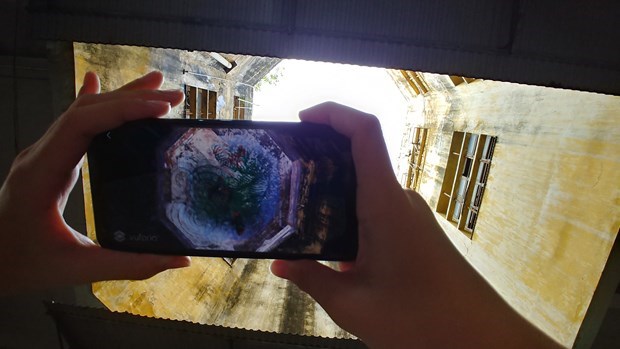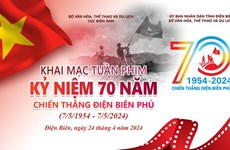Cultural industry renewable and vibrant under digital plan
 Digital platforms enable greater connection with diverse audiences and higher awareness of less-known aspects of culture. (Photo: Artist Nguyen The Son)
Digital platforms enable greater connection with diverse audiences and higher awareness of less-known aspects of culture. (Photo: Artist Nguyen The Son)New investment models for the cultural arts will be the key to open up development opportunities for Vietnam’s creative industry in the international market.
Cooperation needed to create inspiration sources
In recent years, after the COVID-19 pandemic broke out, the digitization of cultural and artistic works in Vietnam has made a lot of progress. Professor Julia Gaimster, Dean of the Faculty of Communication and Design, RMIT University, hailed that as an outstanding achievement after five years of implementing the Prime Minister's Strategy for Cultural Industry Development.
The substantial inclusion of digital cultural content can help attract domestic audiences and introduce contemporary images of Vietnamese culture to international audiences.
Building a digital culture
In 2019, Hanoi people were surprised to see on their phone screens the Cho Hom skylight turned into a pond floating in the air. It was part of the exhibition “Into Thin Air” organized by Manzi Art Space. That “pond” is lacquer-on-glass art work, with a motion effect created by augmented reality (AR) technology.
The Cho Hom's skylight turns into a pond floating in the air. This is an art project by Manzi Art Space. (Photo: Artist Nguyen The Son)
Digital platforms enable greater connection with diverse audiences and raise awareness of lesser-known aspects of culture. Dr. Emma Duester, RMIT University, said: “We can now bring contemporary Vietnamese art and culture closer to the world, rather than only the stereotypical images that circulate online about traditional customs, war, and tourist spots in Vietnam.”
Duester and her partner, Master Michal Teague, have been engaged in studying the digital transformation process of Vietnamese culture and art. They point to challenges including a lack of budget, human and technological resources to digitize art and culture.
“While many discussions nationally are about policy concerning the preservation of cultural heritage and traditional culture, more consideration is necessary on how to make digitized archives publicly accessible and how to best preserve contemporary culture digitally,” Duester said.
The expert also suggested that in the future, Vietnam will need a common, sustainable and accessible digital platform to display influential cultural and artistic works. In this way, the public at home and abroad as well as cultural experts, education and new researchers can access the works freely.
She added that one way to address the challenges is by establishing a digital culture policy for Vietnam to ensure systematic and sustainable development in cultural industry, so that people are aware of issues around copyright and intellectual property rights online.
More specifically, Teague said galleries, libraries, archives and museums in Vietnam need to clearly define their audiences and understand them to ably convey messages effectively.
 (From left) Professor Julia Gaimster, Dr. Emma Duester and Master Michal Teague, a group of experts studying the digital transformation of the arts and culture industry in Vietnam (Source: RMIT)
(From left) Professor Julia Gaimster, Dr. Emma Duester and Master Michal Teague, a group of experts studying the digital transformation of the arts and culture industry in Vietnam (Source: RMIT)Teague said: “Our research has highlighted a lack of resources online about Vietnamese art and culture, which means that educators cannot use authentic resources but instead have to use Western sources.
These involved parties need to collaborate with each other and combine with related sectors such as hotel, tourism, education, manufacturing and public transport to develop live and digital content platforms to attract domestic and international audiences, she recommended.
New investment for culture
From her experience in researching globalization issues, Dr. Nguyen Thi Quy Phuong (former deputy director of the Institute of Journalism and Communication) recommended five solutions to develop Vietnam's cultural industry.
First and foremost, the State needs to classify cultural industry enterprises according to their operational expertise, scale and recognize specific business models with specific professions. On that basis, the Enterprise Law and the Labor Law identify these models and occupations to create the basis for the formation of professional organizations and individuals in the industry.
Second, cultural industry enterprises should be facilitated to access capital sources and mobilize necessary resources for investment in product development.
“This is beneficial for both banks and investors because cultural industrial products often bring significantly higher returns than the investment value. For example, Tran Thanh's movie “Bo gia” (Dad, I’m Sorry) in 2021 invested 23 billion VND (983,535 USD), grossing 600 billion VND in return,” Phuong said.
 Tran Thanh's movie “Bo gia” (Dad, I’m Sorry) earns a huge revenue of 600 billion VND. (Source: Tran Thanh Town)
Tran Thanh's movie “Bo gia” (Dad, I’m Sorry) earns a huge revenue of 600 billion VND. (Source: Tran Thanh Town)Third, to attract investment in infrastructure for the cultural industry, which is the biggest obstacle to the development of the industry, Phuong said the government can implement tax incentives for rent, land, corporate income tax, build-transfer (BT) forms for the private sector to boldly spend their own money building studios, infrastructure for cultural tourism and open creative spaces.
Fourth, the State also needs to support the establishment of investment funds for the cultural industry and associations and agencies to promote the development of the cultural industry according to the model of the National Fund for the Arts. The US model was established in 1965 with a budget of 150 million USD per year. Another example is the establishment of the Thai Creative Economy Office in 2005 with a budget of 20 million USD per annum.
Fifth, to cure the “craziness for foreign products” disease in the Vietnamese cultural market, while ensuring fairness and healthy competition, the government can issue policies to encourage businesses to promote Vietnamese wisdom, attract global wisdom, and prevent brain drain in cultural creative industries.
Associate Professor, Dr. Bui Hoai Son, standing member of the National Assembly's Committee on Culture and Education, expressed his interest in the solution to open up new investment models for the cultural industry. These include opportunities for cultural institutions to diversify their sources of revenue, do business and access different types of finance (including loans) and engage in public-private partnerships.
He affirmed that we live in an era where human creativity is the greatest resource, not coal, oil or any other resource.
“Not only is it the greatest resource, but creativity is also a renewable resource that never vanishes. Any country that is able to make use of the creative resources of its citizens, it will thrive,” he said.
He added that if the policies are implemented synchronously, Vietnam can fully hope to open up the sources of creativity and build a healthy and sustainable cultural industry./.










